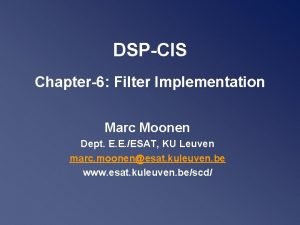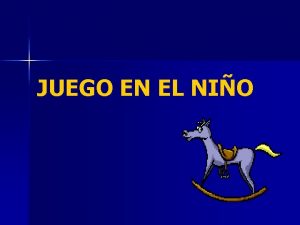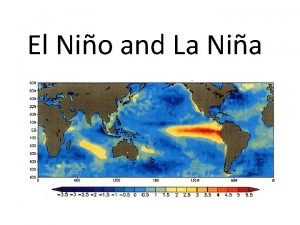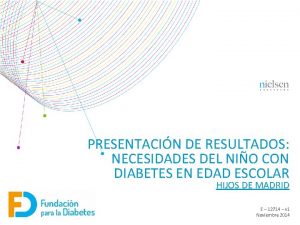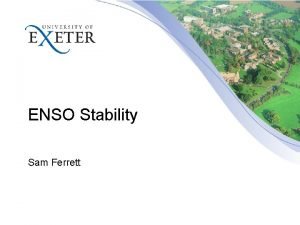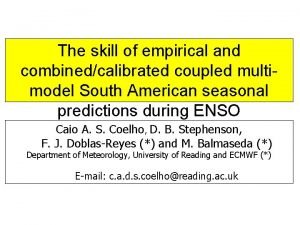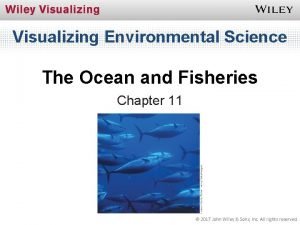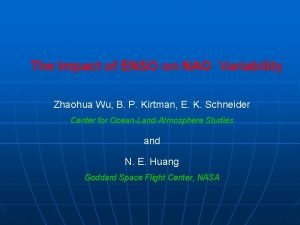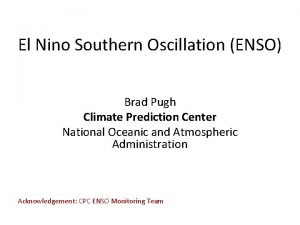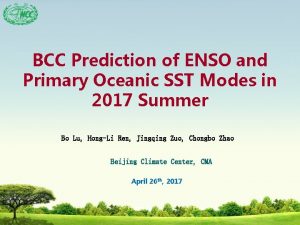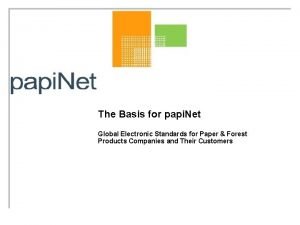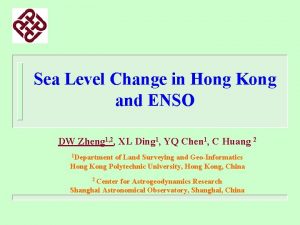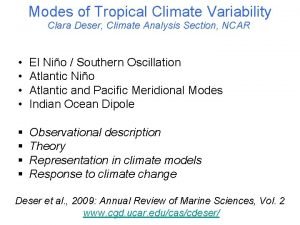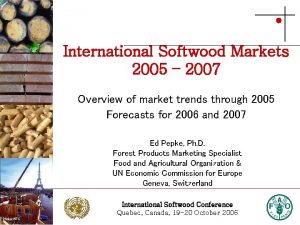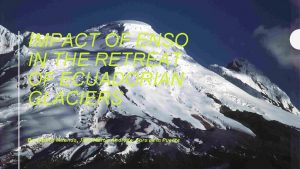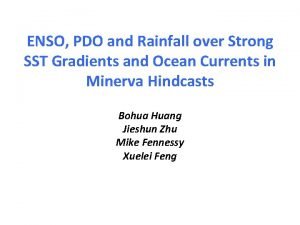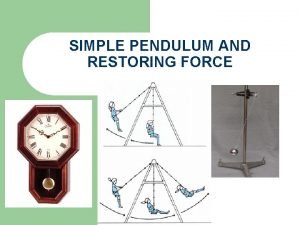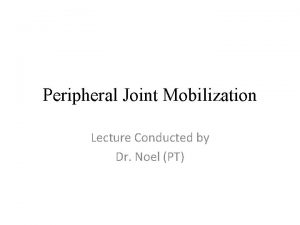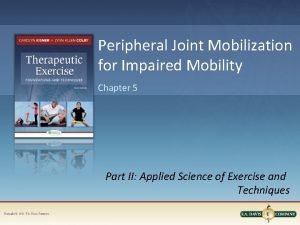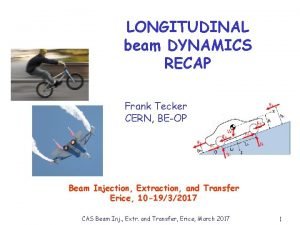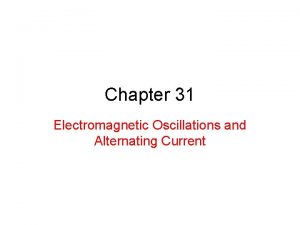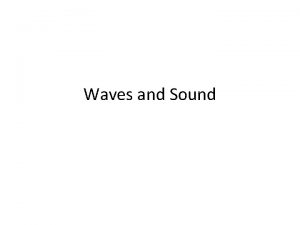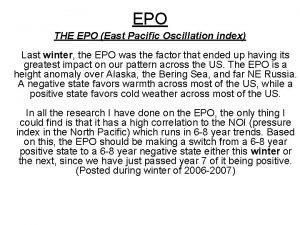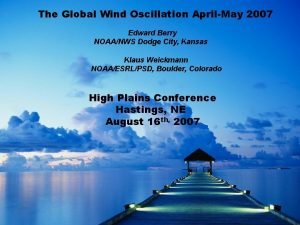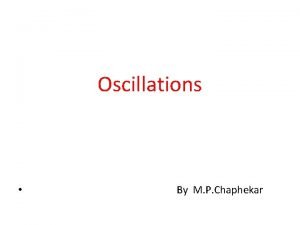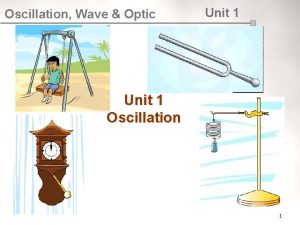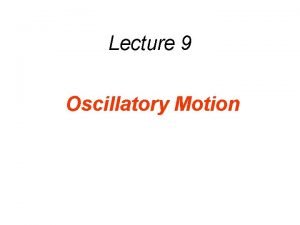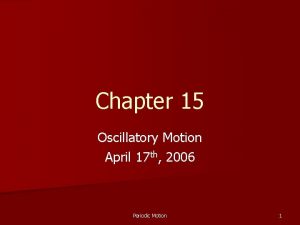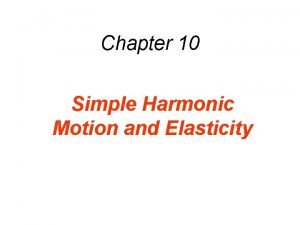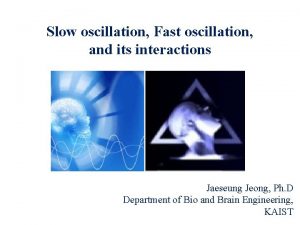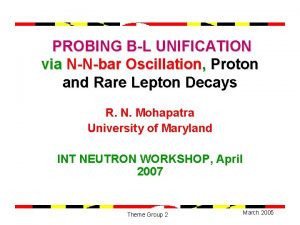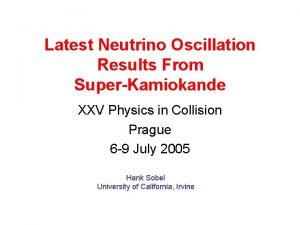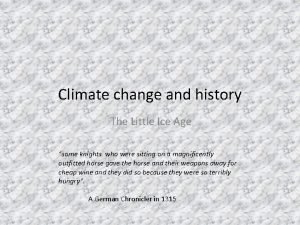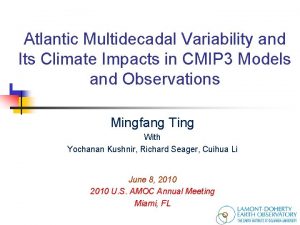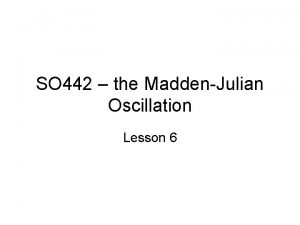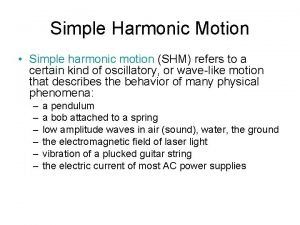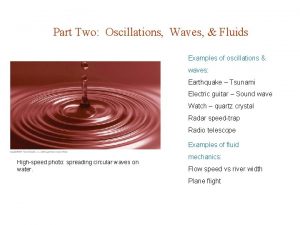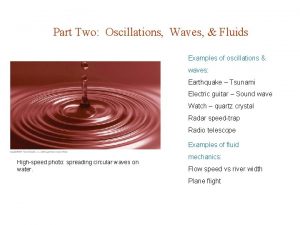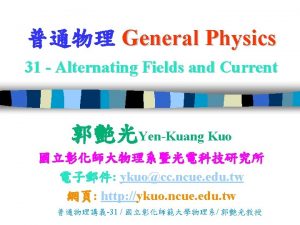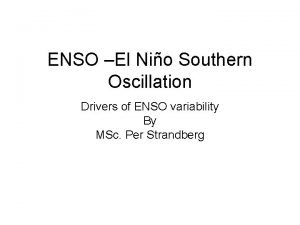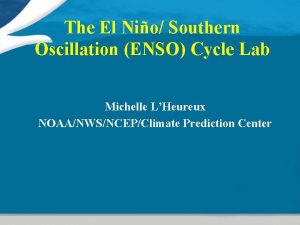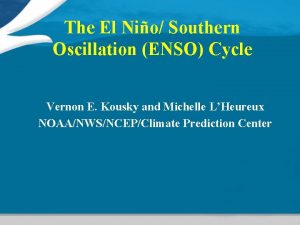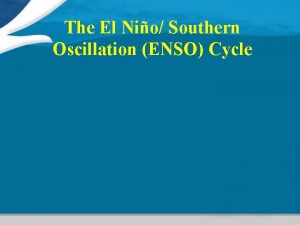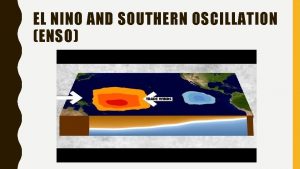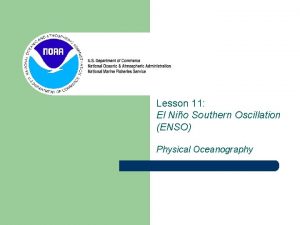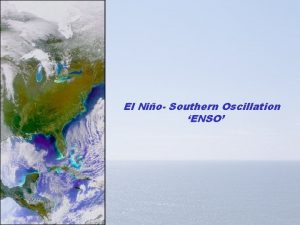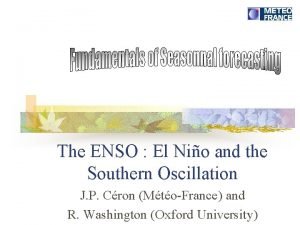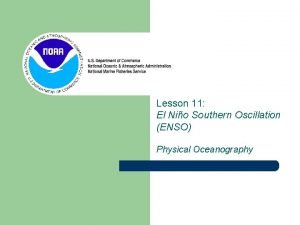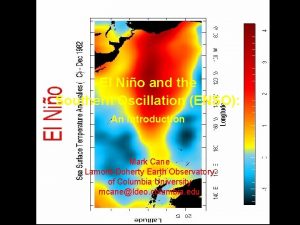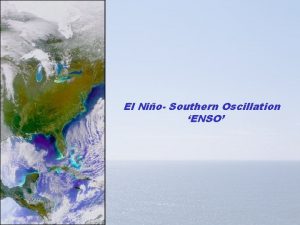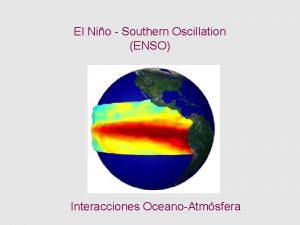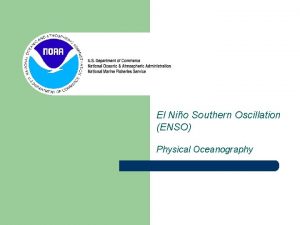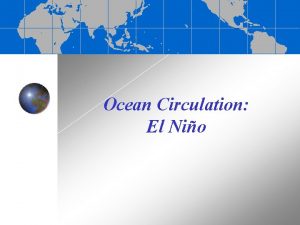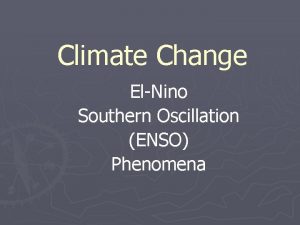The El Nio Southern Oscillation ENSO Cycle Michelle





























































- Slides: 61

The El Niño/ Southern Oscillation (ENSO) Cycle Michelle L’Heureux NOAA/NWS/NCEP/Climate Prediction Center Updated October 2011 Adapted from Vern Kousky’s presentation

The ENSO Cycle • Naturally occurring phenomenon • Equatorial Pacific fluctuates between warmer-than-average (El Niño ) and colder-than-average (La Niña) conditions • The changes in SSTs affect the distribution of tropical rainfall and atmospheric circulation features (Southern Oscillation) • Changes in intensity and position of jet streams and storm activity occur at higher latitudes

Outline (1) Brief Overview of the Ocean and Atmosphere (“Normal” vs. ENSO conditions) (2) The ENSO Cycle: A Coupled Ocean- Atmosphere System (3) ENSO Teleconnections and Global Impacts (4) Upper-level Circulation Changes and Impacts over the Pacific and North America (5) Application to ENSO Monitoring and Prediction at NOAA Climate Prediction Center (CPC)

History of El Niño-Southern Oscillation • “El Niño, ” as a oceanic phenomenon along the coasts of northern Peru and Ecuador, has been documented since the 1500 s. • Sir Gilbert Walker established that a global-scale pressure fluctuation (the “Southern Oscillation”) is related to rainfall anomalies in many areas of the Tropics (e. g. India and South America. • El Niño and the Southern Oscillation were studied as separate phenomena until the 1950 s-1960 s. Important works by Berlage (1956) and J. Bjerknes (late 1960 s) demonstrated a link between the two phenomena.

“Normal” SST: Major Features Atlantic Warm Pool Pacific Warm Pool Cold Tongues

“Normal” SST: Extremes in the Annual Cycle Equatorial SSTs are warmest in April Equatorial cold tongues are strongest in Jul. -Oct.

Sea Surface Temperatures: El Niño vs. La Niña Equatorial cold tongue is weaker than average or absent during El Niño, resulting in positive SST anomalies Equatorial cold tongue is stronger than average during La Niña, resulting in negative SST anomalies

SST Animation: 1997 -1998

“Normal” Precipitation: Major Features Storm Tracks ITCZ SPCZ SACZ

“Normal” Precipitation: Extremes in the Annual Cycle

Precipitation: El Niño vs. La Niña Enhanced rainfall occurs over warmerthan-average waters during El Niño. Reduced rainfall occurs over colderthan-average waters during La Niña.

Sea Level Pressure: “Southern Oscillation” El Niño: Positive SLP anomalies over the western tropical Pacific, Indonesia and Australia. Negative SLP anomalies over eastern tropical Pacific, middle and high latitudes of the North Pacific, and over U. S. Opposite pattern for La Niña. The pressure see-saw between the eastern and western tropical Pacific is known as the “Southern Oscillation. ”

Low-Level Winds & Thermocline Depth: El Niño vs. La Niña: stronger-than-average easterlies lead to a deeper (shallower)-than-average thermocline in the western (eastern) eq. Pacific. El Niño: weaker-than-average easterlies lead to a deeper (shallower)-than-average thermocline in the eastern (western) eq. Pacific.

Animation of Subsurface Temperatures: 1996 -1999

Outline (1) Brief Overview of the Ocean and Atmosphere (“Normal” vs. ENSO conditions) (2) The ENSO Cycle: A Coupled Ocean- Atmosphere System (3) ENSO Teleconnections and Global Impacts (4) Upper-level Circulation Changes and Impacts over the Pacific and North America (5) Application to ENSO Monitoring and Prediction at NOAA Climate Prediction Center (CPC)

ENSO: A Coupled Ocean. Atmosphere Cycle ENSO is a “coupled” phenomenon: atmosphere drives the ocean and the ocean drives the atmosphere. “Positive Feedback” between ocean and atmosphere. Example: Weaker equatorial trade winds cold water upwelling in the east will decrease surface warming of the ocean reduced east-west temperature gradient Weaker equatorial trade winds

What is “Normal? ” Warm Cold (2) Warm water heats the atmosphere and makes it rise, so low-level trade winds blow towards warm water to fill the gap. Subsiding air occurs in the eastern basin. Winds and Sea Surface Temperature are COUPLED. The SSTs determine the winds and vice versa. (1) Easterly trade-winds help push warm water to the western Pacific and upwell cold water in the eastern Pacific Ocean. Warm Cold

“El Niño” Warm Cold NOTE: Location of the warmest SSTs (>28°C) determines where tropical convection will be located. • Convection shifts eastward over the central and/or eastern Pacific Ocean. Convection becomes suppressed over the far western Pacific/ Indonesia. • Easterly trade winds weaken • Thermocline deepens and the cold water upwelling decreases in the eastern Pacific. Warm Cold

“La Niña” Enhanced More Convection Stronger Upwelling Warm Cold • Convection becomes stronger over the far western Pacific Ocean/ Indonesia and more suppressed in the central Pacific. becomes more shallow • Easterly trade winds strengthen • Thermocline becomes more shallow and the cold water upwelling increases in the eastern Pacific. Warm Cold

Typical Evolution of the ENSO Cycle • Irregular cycle with alternating periods of warm (El Niño) and cold (La Niña) conditions • El Niño tends to occur every 3 -4 years and generally lasts 12 -18 months • Strongest El Niño episodes occur every 10 -15 years • La Niña episodes may last from 1 to 3 years • Transitions from El Niño to La Niña are more rapid

What Triggers the onset of ENSO? • Competing ideas on this question (short answer: we don’t know): Paradigm #1: “Delayed-Oscillator Theory: ” a slow-moving ocean wave (a westward moving oceanic Rossby wave) will bounce off the western boundary of the Pacific Ocean and then propagate eastward. Ideally, we could see this Rossby wave many months in advance before it bounces. Paradigm #2: MJO or subseasonal variability will kick off “westerly wind bursts” which are low-level winds in the western Pacific that help to push warm water from the western Pacific to the eastern Pacific (start an eastward moving oceanic Kelvin wave). This mechanism suggests less predictability since MJO onsets are not well predicted. You’ll get a different answer depending on who you ask. My opinion is that it can be both and varies from event to event. Sometimes paradigm #1 applies and sometimes paradigm #2 is a better fit.

Outline (1) Brief Overview of the Ocean and Atmosphere (“Normal” vs. ENSO conditions) (2) The ENSO Cycle: A Coupled Ocean- Atmosphere System (3) ENSO Teleconnections and Global Impacts (4) Upper-level Circulation Changes and Impacts over the Pacific and North America (5) Application to ENSO Monitoring and Prediction at NOAA Climate Prediction Center (CPC)

ENSO Teleconnections Tropical convection/heating can lead to “wavetrains” that can influence the global circulation. EXAMPLE: Eastward expansion of warm sea surface temperatures during El Niño can result in an anomalous eastward shift of convection. Enhanced thunderstorm activity in the central Pacific will perturb the upperlevel flow resulting in an anticyclonic “couplet” straddling the equator. Poleward of the ridge, an anomalous trough forms in the central North Pacific Ocean. Schematic from Horel and Wallace (1981)

Global El Niño Impacts are generally more extensive during the northern winter.

Typical Global El Niño Impacts Region Indonesia Northeast Brazil Central America /Mexico West Coast South America Central South America Southeast Africa Period Life of event March-May May-October Impact Drier March-May Wetter June-December Wetter December-February Drier

Anomalous Precip. (mm/d): Strong El Niño Episodes Rainfall departures, as large as ± 8 mm/d (30 inches in a season), result in changes in the pattern of tropical heating, and changes in the positions and intensities of midlatitude jet streams and planetary waves.

Anomalous Precip. (mm/d): Moderate El Niño Episodes Rainfall departures are less during weak/ moderate warm episodes. Smaller changes occur in the pattern of tropical heating, and in the midlatitude jet streams and planetary waves.

Global La Niña Impacts Mid-latitude impacts generally occur during the winter season (NH – DJF; SHJJA).

Typical Global La Niña Impacts Region Period Impact Indonesia Northeast Brazil Central America /Mexico West Coast South America Central South America Southeast Africa Life of event March-May May-October Wetter March-May Drier June-December Drier December-February Wetter

Anomalous Precip. (mm/d): La Niña Episodes Rainfall departures, as large as ± 8 mm/d (30 inches in a season), result in changes in the pattern of tropical heating, and changes in the mid-latitude jet streams and planetary waves.

New Global ENSO Regressions (courtesy of Peiteo Peng, CPC) http: //www. cpc. ncep. noaa. gov/products/precip/CWlink/ ENSO/regressions/

Outline (1) Brief Overview of the Ocean and Atmosphere (“Normal” vs. ENSO conditions) (2) The ENSO Cycle: A Coupled Ocean- Atmosphere System (3) ENSO Teleconnections and Global Impacts (4) Upper-level Circulation Changes and Impacts over the Pacific and North America (5) Application to ENSO Monitoring and Prediction at NOAA Climate Prediction Center (CPC)

Typical Upper-Level Circulation Changes over the North Pacific and North America • El Niño: Jet stream over North America is stronger than average and shifted equatorward. Flow is more zonal than average from the central Pacific eastward across the U. S. • La Niña: Jet stream over North America is shifted poleward from its normal position. Flow is more meridional than average over the central and eastern Pacific.

Upper-level Winds: El Niño

Upper Level Winds El Niño Episodes

Strong El Nino Pattern over the North Pacific and North America El Niño: Pacific jet stream is stronger than average and shifted southward. Flow is more zonal than average from the central Pacific eastward across the U. S. 36

Typical Impacts of El Niño on North America and the Atlantic Basin • North American summer monsoon region (northern Mexico) – drier than average • U. S. Pacific Northwest fall and winter -- drier than average • Atlantic hurricane season: suppressed activity • Gulf Coast states and, in strong events, central and southern California winter -- wetter than average • Northern Plains, Pacific Northwest, Southern Alaska, and western and central Canada -- warmer than average

Upper-level Winds: La Niña

Upper Level Winds La Niña Episodes

Strong La Nina Pattern over the North Pacific and North America La Niña: Jet stream over North America is shifted poleward from its normal position. Flow is more meridional than average over the central and eastern Pacific.

Typical Impacts of La Niña on North America and the Atlantic Basin • North American summer monsoon region (northern Mexico) – wetter than average • U. S. Pacific Northwest fall and winter -- wetter than average • Atlantic hurricane season: enhanced activity • Southeast U. S. , Gulf Coast states and central and southern California winter -- drier than average • Southwest and Southeast U. S. -- warmer than average

Outline (1) Brief Overview of the Ocean and Atmosphere (“Normal” vs. ENSO conditions) (2) The ENSO Cycle: A Coupled Ocean- Atmosphere System (3) ENSO Teleconnections and Global Impacts (4) Upper-level Circulation Changes and Impacts over the Pacific and North America (5) Application to ENSO Monitoring and Prediction at NOAA Climate Prediction Center (CPC)

Application to Monitoring and Forecasting at NOAA CPC • A sampling of atmospheric and oceanic ENSO indices: SOI, Nino-1+2, Nino-3. 4, Nino-4, ONI • NOAA CPC definitions for ENSO • ENSO Alert System • Forecasting ENSO and its Impacts on the United States • Climate Change and ENSO

Tahiti-Darwin SOI Darwin Tahiti

Niño Regions Largest positive anomalies occur in the eastern equatorial Pacific (Niño 1+2 and 3 regions). Negative anomalies have roughly the same magnitude in all regions.

NOAA Operational ENSO Definition: Oceanic Niño Index (“ONI”) • ONI is defined as the 3 -month average SST departures in the Niño-3. 4 region. Departures are based on a set of improved homogeneous historical SST analyses (Extended Reconstructed SST – ERSST. v 3 b). El Niño: characterized by a positive ONI greater than or equal to +0. 5°C. La Niña: characterized by a negative ONI less than or equal to − 0. 5°C. To be classified as a full-fledged El Niño or La Niña “episode” these thresholds must be exceeded for a period of at least 5 consecutive overlapping 3 -month seasons. The Oceanic Niño Index (ONI) is used to put current events in historical context. Because it is calculated as a 3 -month running mean SST departure it is a “lagging” index, which works better in a retrospective fashion.

ONI: Evolution since 1950 El Niño neutral La Niña

ENSO Alert System: Types of Alerts An El Niño or La Niña Watch: Issued when the environment in the equatorial Pacific basin is favorable for the development of El Niño or La Niña conditions within the next six (6) months. An El Niño or La Niña Advisory: Issued when El Niño or La Niña conditions in the equatorial Pacific basin are observed and expected to continue. Final El Niño or La Niña Advisory: Issued after El Niño or La Niña conditions have ended. NA: The ENSO Alert System will not be active when El Niño or La Niña conditions are not observed or expected to develop in the equatorial Pacific basin.

What triggers an ENSO Advisory? The ENSO Alert System is based on El Niño and La Niña “conditions” that allows the NOAA Climate Prediction Center to be able to issue watches/ advisories in real-time. El Niño conditions: one-month positive SST anomaly of +0. 5 or greater in the Niño 3. 4 region and an expectation that the 3 -month ONI threshold will be met. La Niña conditions: one-month negative SST anomaly of − 0. 5 or less in the Niño 3. 4 region and an expectation that the 3 -month ONI threshold will be met. AND An atmospheric response typically associated with El Niño/ La Niña over the equatorial Pacific Ocean.

Example of Alert System Status CPC’s ENSO Diagnostic Discussion and Climate Diagnostics Bulletin are the primary vehicles used to disseminate real-time information concerning the ENSO Alert System status to the scientific community and general public. User can click on status to get detailed information on Alert System definitions http: //www. cpc. noaa. gov/products/ analysis_monitoring/enso_advisory /ensodisc. html

Forecasting ENSO Forecasters rely on: (1) Real-time data from the equatorial Pacific Ocean (collected from buoys, satellites, etc) and their knowledge of previous ENSO episodes (2) Dynamical models: mathematical equations combined with current observations and run on a computer - NCEP Climate Forecast System (CFS): a “coupled” computer model (ocean and atmosphere interact) (3) Statistical models: use observations of past to make predictions of the future - Consolidated Forecast Tool (“CON”): statistically combines different models to take advantage of independent information provided each model the by

How well do models predict ENSO? • Statistical and Dynamical models have comparable forecast skill [paper in review suggests that Dynamical have started edging the Statistical]. • Models have trouble with transition timing and predicting amplitude of ENSO events. • Stronger ENSO events tend to be better predicted than weaker ones. • “Spring barrier: ” historically, forecasts before the Northern Hemisphere Spring have low skill. • Intraseasonal variability (i. e. MJO) is not captured in most of these models and these phenomenon can have considerable impact on ENSO evolution.

How well do models predict ENSO? Anomaly Correlations between Models and Observations during 2002 -2011 Red Shading: Higher correlations (more skill) White/Blue: Lower correlations ( 0 < r < 0. 5) Light Grey: Negative correlations (very poor skill!) Lead Time (0 -8 months) is on Y-axis and Target Season is on the X-axis The orange box designates the statistical models (the rest are dynamical) From Barnston et al. (BAMS, currently in review) “Skill of Real-Time Seasonal ENSO Model Predictions during 2002 -2011– Is our Capability Increasing? ”

Forecasting ENSO-related Impacts http: //www. cpc. ncep. noaa. gov/products/precip/ CWlink/ENSO/composites/

Forecasting ENSO-related Impacts http: //www. cpc. ncep. noaa. gov/products/precip/ CWlink/ENSO/composites/

U. S. ENSO Impacts U. S. Climate Divisions (clickable map) www. cpc. ncep. noaa. gov/products/precip/CWlink/ENSO/box_whiskers/index. php

What do the ENSO boxplots show? Nov-Jan KEY Upper 1/3 cases Middle 1/3 cases Lower 1/3 cases 90%tile 67%tile Median 33%tile 10%tile http: //www. cpc. ncep. noaa. gov/products/precip/CWlink/ENSO/box_whiskers/index. php

January-March So. CA Coast Fresno Region (CA) Coastal LA Central FL Western KY www. cpc. ncep. noaa. gov/products/precip/CWlink/ENSO/box_whiskers/index. php

Can other climate patterns exert a stronger influence than ENSO? • Short answer: Absolutely. There is uncertainty associated with seasonal forecasts even during strong ENSO episodes. • This is why it is important to emphasize that the existence of ENSO means a “tilt in the odds” toward particular temperature/precipitation anomalies. These anomalies are never guaranteed, which is why climate outlooks are always probabilistic. 2 -meter Temperature anomalies from Reanalysis data for Oct. and Dec. 2009 (during a moderate-strong El Niño). This circulation and temperature pattern was reflective of a very strong negative Arctic Oscillation (AO) pattern.

Climate Change and ENSO • IPCC-AR 4: “No consistent indication at this time of discernible changes in projected ENSO amplitude or frequency in the 21 st century. ” - ENSO projections differ from model to model - Continued ENSO variability in the future even with changes to the background state Fig. 10. 16 from Chapter 10 IPCC AR 4

Summary • ENSO is a naturally occurring phenomenon • Equatorial Pacific fluctuates between warmer-than-average (El Niño ) and colder-than-average (La Niña) conditions • The changes in SSTs affect the distribution of tropical rainfall and atmospheric circulation features (Southern Oscillation) • Changes in intensity and position of jet streams and storm activity occur at higher latitudes
 Enso cycle
Enso cycle Limit cycle oscillation in dsp
Limit cycle oscillation in dsp Nio juego
Nio juego Dr nio
Dr nio Nio fra
Nio fra Nia nio
Nia nio Nio presentacion resultados
Nio presentacion resultados Teemu salmi stora enso
Teemu salmi stora enso What is enso?
What is enso? Enso counseling
Enso counseling Stora enso harjoittelu
Stora enso harjoittelu Visualizing environmental science solution manual
Visualizing environmental science solution manual Enso
Enso El nino defintion
El nino defintion Enso
Enso Papinet
Papinet Enso hk
Enso hk Impermanence symbol
Impermanence symbol Enso international
Enso international Enso stands for
Enso stands for Minerva pdo
Minerva pdo Size separation can be used for
Size separation can be used for Definition of periodic motion
Definition of periodic motion Non-thrust oscillation techniques
Non-thrust oscillation techniques Accessory joint motion
Accessory joint motion Dynamics
Dynamics Sustained translatory technique
Sustained translatory technique Electromagnetic oscillation pdf
Electromagnetic oscillation pdf Disturbance or oscillation
Disturbance or oscillation In the human body
In the human body Bifilar oscillation is the example of mcq
Bifilar oscillation is the example of mcq East pacific oscillation
East pacific oscillation Oscillation mecanique
Oscillation mecanique Renlysis
Renlysis Differential equation of shm
Differential equation of shm Unit for period of a wave
Unit for period of a wave Oscillation
Oscillation Damped oscillation
Damped oscillation Harmonic
Harmonic Slow oscillation
Slow oscillation Oscillation
Oscillation Oscillation
Oscillation 1816 year without summer
1816 year without summer Amo atlantic multidecadal oscillation
Amo atlantic multidecadal oscillation Madden julian oscillation
Madden julian oscillation Frequency of shm
Frequency of shm Harmonic oscillator
Harmonic oscillator Forced oscillation
Forced oscillation Oscillation
Oscillation Rlc oscillation
Rlc oscillation Hát kết hợp bộ gõ cơ thể
Hát kết hợp bộ gõ cơ thể Ng-html
Ng-html Bổ thể
Bổ thể Tỉ lệ cơ thể trẻ em
Tỉ lệ cơ thể trẻ em Voi kéo gỗ như thế nào
Voi kéo gỗ như thế nào Tư thế worms-breton
Tư thế worms-breton Chúa yêu trần thế alleluia
Chúa yêu trần thế alleluia Các môn thể thao bắt đầu bằng tiếng nhảy
Các môn thể thao bắt đầu bằng tiếng nhảy Thế nào là hệ số cao nhất
Thế nào là hệ số cao nhất Các châu lục và đại dương trên thế giới
Các châu lục và đại dương trên thế giới Công thức tính độ biến thiên đông lượng
Công thức tính độ biến thiên đông lượng Trời xanh đây là của chúng ta thể thơ
Trời xanh đây là của chúng ta thể thơ

